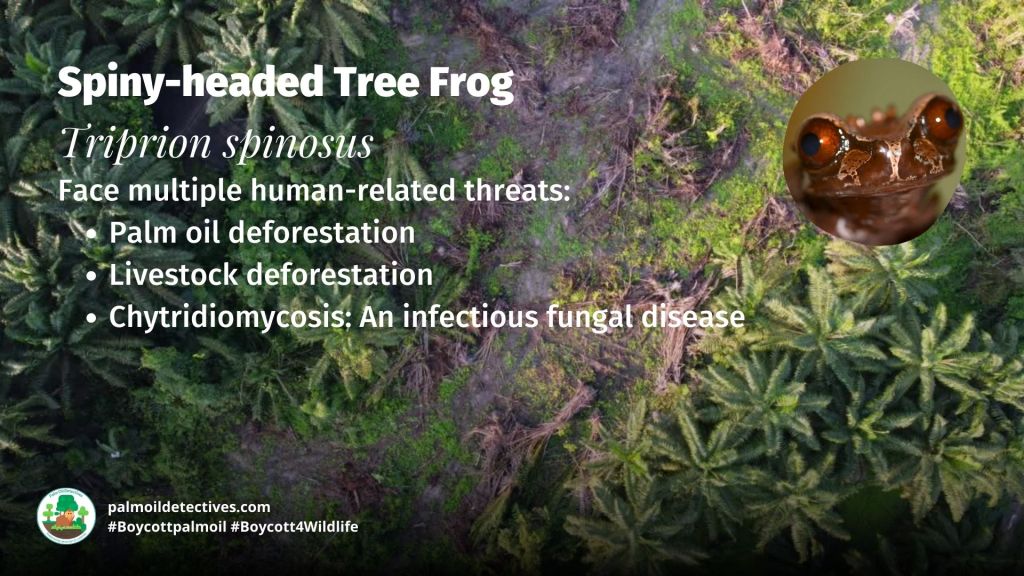Spiny-headed Tree Frog Triprion spinosus
Tiny and cute frogs in #Panama #Honduras, Spiny-headed Tree Frogs are Near Threatened from #deforestation. Help them and use your wallet as a weapon #Boycottpalmoil #Boycott4Wildlife
Tweet
Spiny-headed Tree Frogs of #Mexico #CostaRica are Near Threatened by deforestation. Males make a “boop…boop” sound when calling to females. Fight for them each time you shop and #Boycottpalmoil #Boycott4Wildlife
Tweet
Near Threatened
Extant (resident)
Costa Rica (Costa Rica (mainland)); Honduras (Honduras (mainland)); Mexico (Chiapas, Oaxaca, Puebla, Veracruz, Tabasco); Panama
Possibly Extant (resident)
Nicaragua
The Spiny-headed Tree Frog Triprion spinosus is a stunning small frog species hanging on to survival in fragmented patches of forest in Costa Rica, Panama, Honduras, Mexico. They have many common names including the spiny-headed tree frog, spiny-headed treefrog, spinyhead treefrog, coronated treefrog, and the crowned hyla.
Appearance & Behaviour
They lack vocal sacs or slits however their loud “boop-boop-boop” call can be heard from up to 100 meters away.
A shy, arboreal species, Spiny-headed Tree Frogs are rarely seen and they live out their lives quietly in bromeliads and other tropical plants. They can be found in the subtropical forests of mountain ranges. They prefer intact forest and secondary growth forest. They have on occasion been observed living in coffee plantations.
They are light brown with darker brown markings and a black belly. It takes them between 60 to 136 days to morph from tadpole to mature frog depending on the number of surviving tadpoles and the competition for food. Their life span is 10 to 15 years.






Threats
As breeding takes place in the watery hollows of plants and trees, Spiny-headed Tree Frogs face enormous threat from deforestation.
This beautiful tiny frog faces several anthropogenic threats
- Chytridiomycosis: An infectious fungal disease that is capable of causing sporadic deaths in some amphibian populations and 100% mortality in others.
- Deforestation: for timber, soy and palm oil throughout their region.
- Deforestation: for livestock grazing across their range.
A captive “insurance population” is bred and maintained by the El Valle Amphibian Conservation Center, Panama, Atlanta Botanical Garden, United States, and a few AZA zoos.


Habitat & geographic range
Human-related threats constrict their ecological range and there are now fragmented populations in Costa Rica, Honduras, Panama and Mexico. Like many frogs they are nocturnal and most active at night time.
Diet
They prefer to eat insects and small arthropods and worms. Tadpoles will eat unfertilised eggs that are deposited by their mothers.
Mating and breeding
Males have a distinctive “boop..boop…boop” sound and call to females from within the water-filled hollows and crevices of bromeliad rosettes and bamboo internodes.
Females approach the calling males and clasp them immediately and together pair dive into the water. The female will lay between 50 to 300 eggs and then the male fertilises them. Only one in 25 eggs will hatch, which takes around a week to occur.
The watery catchment where female lays her eggs is safe sanctuary away from potential predators. Developing tadpoles will eat unfertilised eggs laid by the mother. The mother will return to visit egg laying locations to lay more unfertilised eggs for the tadpoles to feed on. Tadpoles will prompt their mother to do this by nibbling on her belly.
Support Spiny-headed Tree Frog by going vegan and boycotting palm oil in the supermarket, it’s the #Boycott4Wildlife

Support the conservation of this species
This animal has no protections in place. Read about other forgotten species here. Create art to support this forgotten animal or raise awareness about them by sharing this post and using the #Boycottpalmoil #Boycott4Wildlife hashtags on social media. Also you can boycott palm oil in the supermarket.
Further Information
IUCN SSC Amphibian Specialist Group. 2020. Triprion spinosus. The IUCN Red List of Threatened Species 2020: e.T55296A3028482. https://dx.doi.org/10.2305/IUCN.UK.2020-3.RLTS.T55296A3028482.en. Accessed on 31 October 2022.
Spiny-headed Tree Frog Triprion spinosus on Wikipedia
Spiny-headed Tree Frog Triprion spinosus on Animalia.bio


How can I help the #Boycott4Wildlife?
Contribute in five ways
1. Join the #Boycott4Wildlife on social media and subscribe to stay in the loop: Share posts from this website to your own network on Twitter, Mastadon, Instagram, Facebook and Youtube using the hashtags #Boycottpalmoil #Boycott4Wildlife.
2. Contribute stories: Academics, conservationists, scientists, indigenous rights advocates and animal rights advocates working to expose the corruption of the palm oil industry or to save animals can contribute stories to the website.
3. Supermarket sleuthing: Next time you’re in the supermarket, take photos of products containing palm oil. Share these to social media along with the hashtags to call out the greenwashing and ecocide of the brands who use palm oil. You can also take photos of palm oil free products and congratulate brands when they go palm oil free.
4. Take to the streets: Get in touch with Palm Oil Detectives to find out more.
5. Donate: Make a one-off or monthly donation to Palm Oil Detectives as a way of saying thank you and to help pay for ongoing running costs of the website and social media campaigns. Donate here








One thought on “Spiny-headed Tree Frog Triprion spinosus”